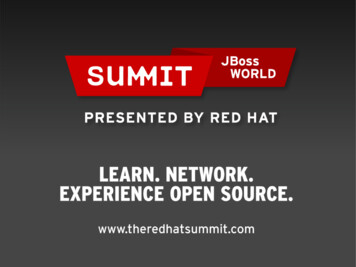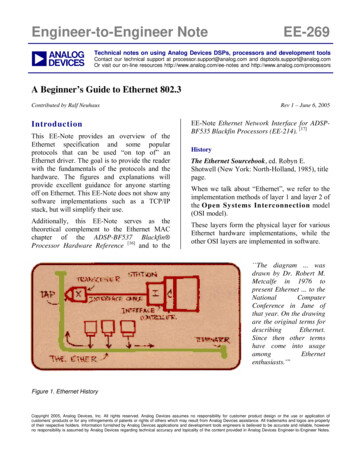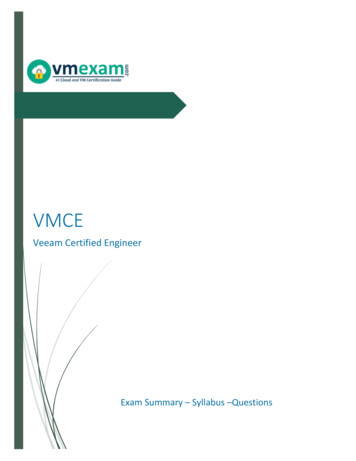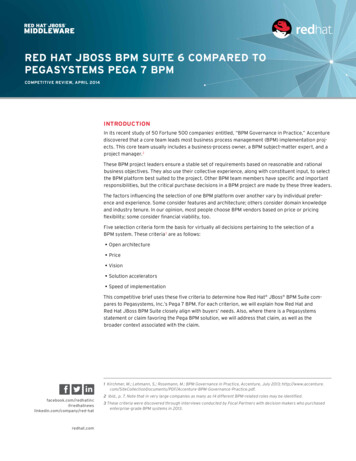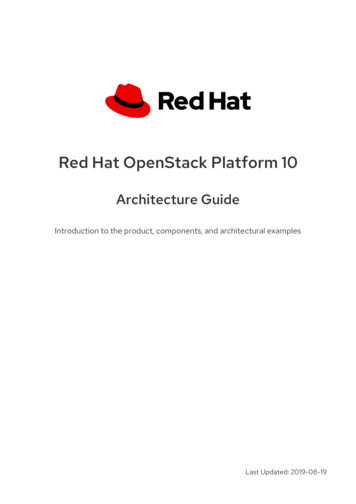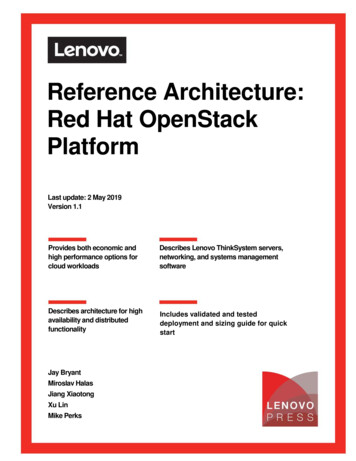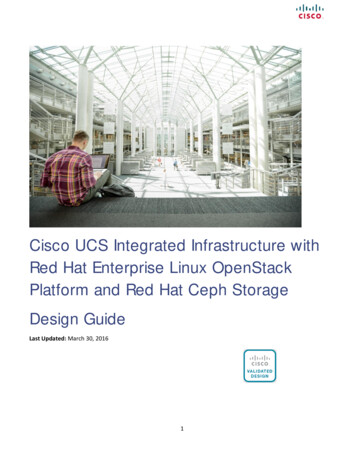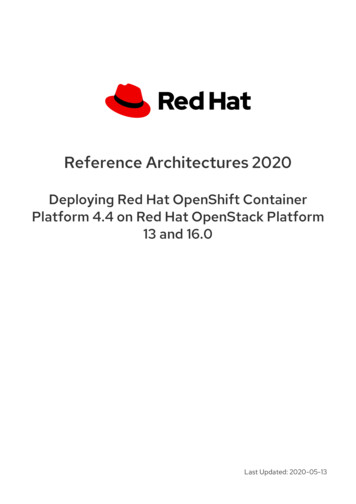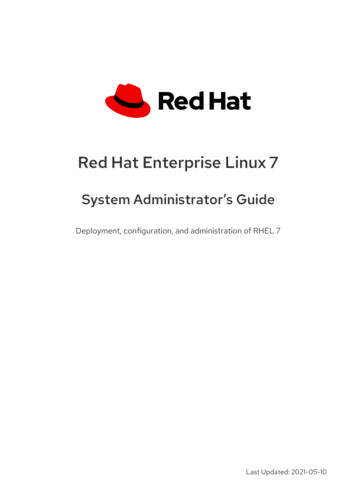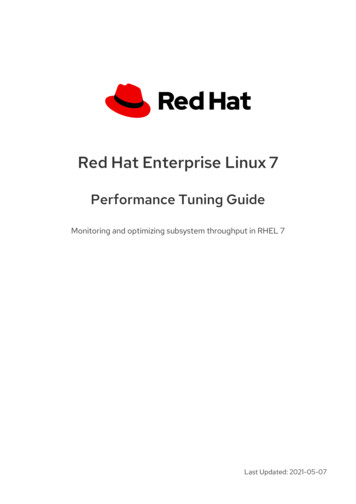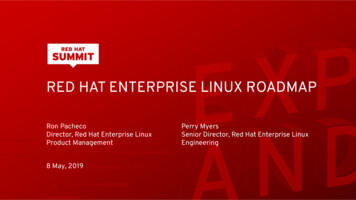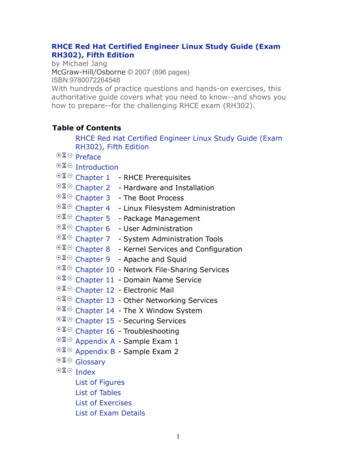
Transcription
RHCE Red Hat Certified Engineer Linux Study Guide (ExamRH302), Fifth Editionby Michael JangMcGraw-Hill/Osborne 2007 (896 pages)ISBN:9780072264548With hundreds of practice questions and hands-on exercises, thisauthoritative guide covers what you need to know--and shows youhow to prepare--for the challenging RHCE exam (RH302).Table of ContentsRHCE Red Hat Certified Engineer Linux Study Guide (ExamRH302), Fifth EditionPrefaceIntroductionChapter 1 - RHCE PrerequisitesChapter 2 - Hardware and InstallationChapter 3 - The Boot ProcessChapter 4 - Linux Filesystem AdministrationChapter 5 - Package ManagementChapter 6 - User AdministrationChapter 7 - System Administration ToolsChapter 8 - Kernel Services and ConfigurationChapter 9 - Apache and SquidChapter 10 - Network File-Sharing ServicesChapter 11 - Domain Name ServiceChapter 12 - Electronic MailChapter 13 - Other Networking ServicesChapter 14 - The X Window SystemChapter 15 - Securing ServicesChapter 16 - TroubleshootingAppendix A - Sample Exam 1Appendix B - Sample Exam 2GlossaryIndexList of FiguresList of TablesList of ExercisesList of Exam Details1
Getting Red Hat Enterprise LinuxThe Red Hat exams are based on your knowledge of Red Hat Enterprise Linux.When you take the RHCE exam, it'll be on a "standard" PC with Intel 32-bit (orcompatible) personal computers. The CPU should have a speed of at least700MHz, and the PC should have at least 256MB of RAM. As Red Hat Networkupdates are not explicitly listed as a requirement in the Red Hat Exam Prepguide, a "trial" subscription or a rebuild distribution is probably sufficient. If youwant a full subscription, which can help you test features associated with the RedHat Network, the price depends on your hardware and the amount of support youneed. I've emphasized Red Hat solely to focus on distributions that use Red Hatsource code, including the "rebuilds" described in this section (and more).With Red Hat Enterprise Linux 5, Red Hat has modified its offerings into twocategories: RHEL Server includes varying levels of support for entry-level to high-endand mission-critical systems.o The RHEL Server Advanced Platform supports unlimited virtualizedguests, virtualized storage, high-availability clustering and failover, withsupport for more than two CPUs.o RHEL Server subscriptions are available for IBM System Z mainframesystems on a per-processor basis.o RHEL Server subscriptions are also available for High PerformanceComputing clusters. RHEL Desktop includes varying levels of support suitable for desktopcomputers and workstations. There are different options available forsystems with one or more CPUs.If you want to prepare for the RHCE exam with the official RHEL 5 serveroperating system, trial subscriptions are available(www.redhat.com/en us/USA/home/developer/trial/). While they only supportupdates for 30 days, updates can also be tested using the mirror repositoriesassociated with rebuild distributions. And you can download the same operatingsystem (for the trial period) from the same sources as paying Red Hat users.But you don't have to pay for the operating system or settle for a "trialsubscription" to prepare for the RHCE exam. There are a wide variety of effortsto create "rebuilds" of Red Hat Enterprise Linux. The source code for almost allRHEL RPM packages is released under the Linux General Public License (GPL)or related licenses. This gives anyone the right to build Red Hat Enterprise Linuxfrom the Red Hat released source code.The source code is released in Source RPM package format, which means theRPM packages can be built using the rpm commands described in Chapter 5.The developers behind rebuild distributions have all revised the source code to2
remove Red Hat trademarks. Most, like CentOS-5, are freely available; others,like Oracle Linux, require a subscription.On theOracle Linux has tried to undercut Red Hat by developingJobtheir own rebuild of Red Hat Enterprise Linux. Theirsubscriptions cost less at what I presume are similar supportlevels. As I have not tried Oracle Linux, I do not know if youget the same level of knowledge that you would get from RedHat engineers.You can select and download the rebuild that most closely meets your needs. Ihave tried several of the rebuilds, including those developed by CommunityEnterprise Linux (CentOS), Scientific Linux, and Lineox. All have proven reliable.In fact, they are so popular, some suggest that it has led to the demise of theFedora Legacy project, which supported older versions of Fedora Core untilDecember of 2006.The rebuilds of RHEL are freely available; however, you should have a highspeed Internet connection. While these rebuilds do not use 100 percent RHELsoftware, I have not seen any difference that would impair your ability to study forthe Red Hat exams. Community Enterprise Linux The Community Enterprise Operating System(CentOS) rebuild developed by the group at www.centos.org appears solid tome. This group probably has the largest community (or at least gets the mostpublicity) among the rebuilds. Scientific Linux Formerly known as Fermi Linux, it includes a lot ofintellectual firepower associated with the Fermi National Accelerator Lab aswell as CERN, the lab associated with Tim Berners-Lee, the person mostcommonly credited with the invention of the World Wide Web. Lineox Lineox is based in Finland and offers priority updates for a fee. It maybe especially interesting for people in the European Union, as their prices arein Euros. You can find out more about Lineox at www.lineox.net.Alternatively, you can work from RHEL Desktop, if you're willing to installadditional services from the source code. For more information on installingpackages from source code, see Chapters 1, 5, and 8. Using the techniquesdescribed in Chapter 5, you can download the Red Hat Enterprise Linux SourceRPMs at ftp.redhat.com, process them into binary RPMs, and then install themon your computer.For the RHCE exams based on Red Hat Enterprise Linux 5, you can probablyalso work from Fedora Core 6, as RHEL 5 is based on this Red Hat communitydistribution.3
In This BookThe Red Hat RHCT and RHCE exams are designed to test candidatequalifications as Linux systems technicians and engineers. If you pass either ofthese exams, it's not because you've memorized a canned set of answers—it'sbecause you have a set of Linux administrative skills and know how to use themunder pressure, whether it be during an exam or in a real-world situation.While this book is organized to serve as an in-depth review for the RHCT andRHCE exams for both experienced Linux and Unix professionals, it is notintended as a substitute for Red Hat courses, or more importantly, real-worldexperience. Nevertheless, each chapter covers a major aspect of the exam, withan emphasis on the "why" as well as the "how to" of working with and supportingRHEL as a systems administrator or engineer. As the actual RHCT and RHCEExam Prep guide (www.redhat.com/rhce/examprep.html) changes with everyrelease of RHEL (and even sometimes between releases), refer to the notedURL for the latest information. (Throughout the book, I often refer to the RHCTand RHCE Exam Prep guide as the Red Hat Exam Prep guide, even thoughthere are Red Hat exams for certifications other than the RHCT and RHCE.)Red Hat says it's important to have real-world experience to pass their exams,and they're right! However, for the RHCT and RHCE exams, they do focus on aspecific set of Linux administrative skills, as depicted in the Red Hat Exam Prepguide. This book is intended to help you take advantage of the skills you alreadyhave—and more importantly, brush up in those areas where you may have a bitless experience.This book includes relevant information from Red Hat Enterprise Linux 5 (RHEL5). There are significant changes from Red Hat Enterprise Linux 4; As of thiswriting, Red Hat even offers a course detailing the differences (RHUP 304 andRHUP 305). Several key differences between RHEL 4 and RHEL 5 include: A new hardware detection model. The udev system readily supportsautomatic mounting and configuration of a wide variety of devices. Multicore support. Fundamental to effective virtualization, multicore CPUscan help multiple operating systems run simultaneously on the same physicalsystem. Red Hat includes Xen in RHEL 5 to take advantage of the latestmulticore CPUs. Logical Volume Management (LVM), version 2, which supports smootherresizing of filesystems. Software RAID now supports more modes, including RAID 6. The associatedtool is more flexible. NFS supports "stateless" network and loopback images. yum replaces Up2Date for repository and package management as well asupdates. The Network Manager incorporates improvements in wireless networking andmore, which eases administration on the desktop.4
SELinux is now easier to use and administer. The descriptions in the SecurityLevel Configuration tool are improved, and sealert -b browser can help youdiagnose many SELinux-related issues.There are many more key features; those that I believe are relevant to the RHCTand RHCE exams, as defined by the publicly available course outlines and theExam Prep guide, are also included in this book.While it's a risky practice in service, it is fastest to administer RHEL during theexam by logging into the root user account. The command prompt and PATHassume use of that account. When you're logged into the root account, you'll seea command line prompt similar to:[root@Enterprise root]#As the length of this prompt would lead to a number of broken and wrapped codelines throughout this book, I've normally abbreviated the root account prompt as:#Be careful. The hash mark (#) is also used as a comment character in Linuxscripts and programs; for example, here is an excerpt from /etc/inittab:# Default runlevel. The runlevels used by RHS are:When logged in as a regular user, the prompt is slightly different; for usermichael, it would typically look like the following:[michael@Enterprise michael] Similarly, I've abbreviated this as: There are a number of command lines and code interspersed throughout thechapters.Exam Readiness ChecklistAt the end of the introduction, you will find an Exam Readiness Checklist. Thistable has been constructed to allow you to cross-reference the official examobjectives with the objectives as they are presented and covered in this book.The checklist also allows you to gage your level of expertise on each objective atthe outset of your studies. This should allow you to check your progress andmake sure you spend the time you need on more difficult or unfamiliar sections.References have been provided for the objective exactly as the vendor presentsit, the section of the study guide that covers that objective, and a chapter andpage reference.5
In Every ChapterFor this series, we've created a set of chapter components that call your attentionto important items, reinforce important points, and provide helpful exam-takinghints. Take a look at what you'll find in every chapter: Every chapter begins with the Certification Objectives—the skills you needto master in order to pass the section on the exam associated with thechapter topic. The Objective headings identify the objectives within thechapter, so you'll always know an objective when you see it. Exam Watch notes call attention to information about, and potential pitfallsin, the exam. These helpful hints are written by authors who have taken theexams and received their certification—who better to tell you what to worryabout? They know what you're about to go through! Practice Exercises are interspersed throughout the chapters. These arestep-by-step exercises that allow you to get the hands-on experience youneed in order to pass the exams. They help you master skills that are likely tobe an area of focus on the exam. Don't just read through the exercises; theyare hands-on practice that you should be comfortable completing. Learningby doing is an effective way to increase your competency with a product.Remember, the Red Hat exams are entirely "hands-on;" there are no multiplechoice questions on these exams.On thenotes describe the issues that come up most often in realJobworld settings. They provide a valuable perspective oncertification- and product-related topics. They point outcommon mistakes and address questions that have arisenfrom on-the-job discussions and experience.Inside the Exam sidebars highlight some of the most common and confusingproblems that students encounter when taking a live exam. Designed toanticipate what the exam will emphasize, getting inside the exam will help ensureyou know what you need to know to pass the exam. You can get a leg up on howto respond to those difficult-to-understand labs by focusing extra attention onthese sidebars. Scenario & Solution sections lay out potential problems and solutions in aquick-to-read format.The Certification Summary is a succinct review of the chapter and arestatement of salient skills regarding the exam.The Two-Minute Drill at the end of every chapter is a checklist of the mainpoints of the chapter. It can be used for last-minute review.The Self Test offers "fill in the blank" questions designed to help test thepractical knowledge associated with the certification exams. The answers tothese questions, as well as explanations of the answers, can be found at theend of each chapter. By taking the Self Test after completing each chapter,you'll reinforce what you've learned from that chapter.The Lab Questions at the end of the Self Test section offer a unique andchallenging question format that requires the reader to understand multiple6
chapter concepts to answer correctly. These questions are more complexand more comprehensive than the other questions, as they test your ability totake all the knowledge you have gained from reading the chapter and apply itto complicated, real-world situations. Most importantly, the Red Hat examscontain onl
RHCE Red Hat Certified Engineer Linux Study Guide (Exam RH302), Fifth Edition by Michael Jang McGraw-Hill/Osborne 2007 (896 pages) ISBN:9780072264548 With hundreds of practice questions and hands-on exercises, this authoritative guide covers what you need to know--and shows you how to prepare--for the challenging RHCE exam (RH302).
